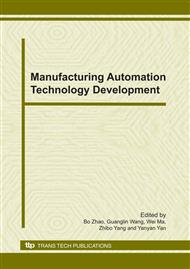p.42
p.47
p.52
p.59
p.66
p.72
p.76
p.81
p.87
Quality Control and Tracing System of Automotive Airbag Flexible Assembly Line
Abstract:
As an important component of automobile, the quality control and tracility of airbag’s manufacturing process is very important. In this situation, an assembly line is put forward which is made up of computer, barcode scanner, electric nut runner and specialized electric testing instrument. System uses the Client/Server framework , bar code technology and SQL database to save or find the assembly data and the information of the operators. Electric nut runner is used to control the torque value of the nuts. Specialized electric testing instrument is used to test the electric parameters of the airbag. By the practical application in the assembly line, there are many advantages of this system such as good human-machine interface, fast response, and so on. This system can be used for many products, and it is an flexible assemble line with procedures rectification, quality control and product tracing.
Info:
Periodical:
Pages:
66-71
Citation:
Online since:
December 2010
Authors:
Price:
Сopyright:
© 2011 Trans Tech Publications Ltd. All Rights Reserved
Share:
Citation:


